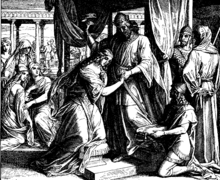
Back تزاوج فوقي Arabic Hypergami Danish Hypergamie German Hipergamia Spanish Hüpergaamia Estonian هایپرگامی Persian Hypergamia Finnish Hypergamie French היפרגמיה HE अनुलोम विवाह Hindi
Relationships (Outline) |
|---|

Hypergamy (colloquially referred to as "dating up" or "marrying up"[1]) is a term used in social science for the act or practice of a person dating or marrying a spouse of higher social status or sexual capital than themselves.
The antonym "hypogamy"[a] refers to the inverse: marrying a person of lower social class or status (colloquially "marrying down"). Both terms were invented in the Indian subcontinent in the 19th century while translating classical Hindu law books, which used the Sanskrit terms anuloma and pratiloma, respectively, for the two concepts.[2]
The term hypergyny is used to describe the overall practice of women marrying up, since the men would be marrying down.[3]
- ^ Abgarian, Almara (21 October 2018). "What is hypergamy and are some people prone to it?". metro.co.uk. Retrieved 2 July 2019.
- ^ Shah, A. M. (6 December 2012), The Structure of Indian Society: Then and Now, Routledge, pp. 37–, ISBN 978-1-136-19770-3
- ^ Dickemann, Mildred (May 1979). "The ecology of mating systems in hypergynous dowry societies". Social Science Information. 18 (2): 163–195. doi:10.1177/053901847901800201. S2CID 144749330.
It seemed clear from my materials that, as long ago proposed by Risley (1908) and Rivers (1921), this practice was a product of hypergyny, the upward flow of brides in a society which, being pyramidal, had fewer grooms at the top
Cite error: There are <ref group=lower-alpha> tags or {{efn}} templates on this page, but the references will not show without a {{reflist|group=lower-alpha}} template or {{notelist}} template (see the help page).
© MMXXIII Rich X Search. We shall prevail. All rights reserved. Rich X Search